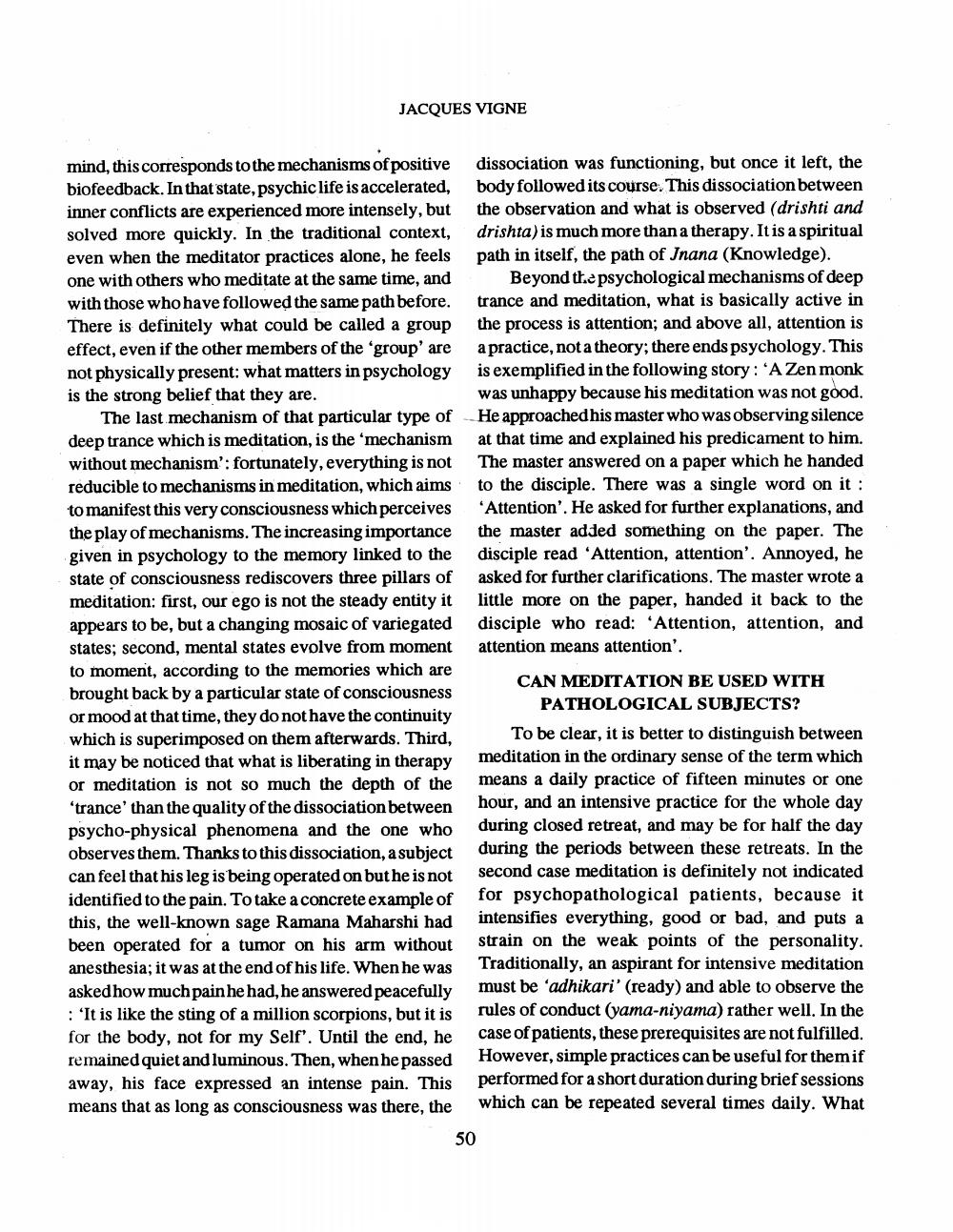________________
JACQUES VIGNE
mind, this corresponds to the mechanisms of positive biofeedback. In that state, psychic life is accelerated, inner conflicts are experienced more intensely, but solved more quickly. In the traditional context, even when the meditator practices alone, he feels one with others who meditate at the same time, and with those who have followed the same path before. There is definitely what could be called a group effect, even if the other members of the group' are not physically present: what matters in psychology is the strong belief that they are.
The last mechanism of that particular type of deep trance which is meditation, is the mechanism without mechanism': fortunately, everything is not reducible to mechanisms in meditation, which aims to manifest this very consciousness which perceives the play of mechanisms. The increasing importance given in psychology to the memory linked to the state of consciousness rediscovers three pillars of meditation: first, our ego is not the steady entity it appears to be, but a changing mosaic of variegated states; second, mental states evolve from moment to moment, according to the memories which are brought back by a particular state of consciousness or mood at that time, they do not have the continuity which is superimposed on them afterwards. Third, it may be noticed that what is liberating in therapy or meditation is not so much the depth of the 'trance' than the quality of the dissociation between psycho-physical phenomena and the one who observes them. Thanks to this dissociation, a subiect can feel that his leg is being operated on but he is not identified to the pain. To take a concrete example of this, the well-known sage Ramana Maharshi had been operated for a tumor on his arm without anesthesia; it was at the end of his life. When he was asked how much pain he had, he answered peacefully : 'It is like the sting of a million scorpions, but it is for the body, not for my Self'. Until the end, he remained quiet and luminous. Then, when he passed away, his face expressed an intense pain. This means that as long as consciousness was there, the
dissociation was functioning, but once it left, the body followed its course. This dissociation between the observation and what is observed (drishti and drishta) is much more than a therapy. It is a spiritual path in itself, the path of Jnana (Knowledge).
Beyond the psychological mechanisms of deep trance and meditation, what is basically active in the process is attention; and above all, attention is a practice, not a theory; there ends psychology. This is exemplified in the following story: A Zen monk was unhappy because his meditation was not good. He approached his master who was observing silence at that time and explained his predicament to him. The master answered on a paper which he handed to the disciple. There was a single word on it : 'Attention'. He asked for further explanations, and the master added something on the paper. The disciple read 'Attention, attention'. Annoyed, he asked for further clarifications. The master wrote a little more on the paper, handed it back to the disciple who read: 'Attention, attention, and attention means attention'.
CAN MEDITATION BE USED WITH
PATHOLOGICAL SUBJECTS?
To be clear, it is better to distinguish between meditation in the ordinary sense of the term which means a daily practice of fifteen minutes or one hour, and an intensive practice for the whole day during closed retreat, and may be for half the day during the periods between these retreats. In the second case meditation is definitely not indicated for psychopathological patients, because it intensifies everything, good or bad, and puts a strain on the weak points of the personality. Traditionally, an aspirant for intensive meditation must be 'adhikari' (ready) and able to observe the rules of conduct (yama-niyama) rather well. In the case of patients, these prerequisites are not fulfilled. However, simple practices can be useful for them if performed for a short duration during brief sessions which can be repeated several times daily. What
50




